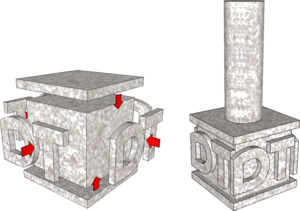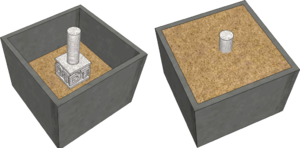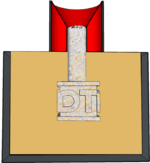Lost Foam Casting
From DT Online
Description
Lost Foam Casting in Aluminium is very similar to Investment Casting (e.g. as used by Jewellers and Dentists) except the finished casting is the result of evaporating Polystyrene out of the mould rather than melting wax.
The process lends itself to complex and sculptural shapes which would be difficult to remove from a mould. By its nature, the process can leave a rough surface (reflecting the surface of a polystyrene ceiling tile for example). This can sometimes be machined off or can be left as a textural feature of the finished product.
Polystyrene Patterns
The polystyrene Patterns are sacrifical since the molten metal completely evaporates them and burns them out during the process. They can be made by sculpturing out of a solid block of polystyrene using a soldering iron or similar, or assembled from a number of parts cut out from polystyrene sheet using a Hot Wire Cutter for example.
A polystyrene Sprue is integrated into the pattern to create an entry point for the molten metal.
Safety Point! The smoke and fumes given off is primarily CO2, soot and water vapour, but with small amounts of more toxic ingredients and so, as with all fume producing processes, Lost Foam Casting should be done either outside or with Local Exhaust Ventilation (LEV). Do not use any foams without researching the toxicity of any fumes given off.
Lost Foam Moulding
For casting Aluminium this process can be very simple indeed. Find, or make, a suitable size container and simply bury the polystyrene pattern in dry silver sand (e.g. Play Pit sand) ensuring that the polystyrene Sprue protrudes.
Position a conventional sand-filled Runner Cup over the protruding Sprue to help pour the Aluminium in one steady continuous pour.
Surprisingly perhaps, the molten Aluminium simultaneously evaporates or burns out the polystyrene and fills the space it was occupying within the sand, to result in an Aluminium cast replica.
Sprues are sawn off and the cast surfaces machined as needed to create the end product.
Safety Point! Pouring molten metal is extremely dangerous!
- Ensure there are no trip hazards between the furnace and the moulding tray containing the flask.
- Make sure that any tools introduced into the melt (e.g. to remove Dross) are pre-heated and dry.
- Wear full face shield, leather gauntlets and apron.
- Use purpose made Crucible Tongs and Carriers to carry the Crucible to the moulding tray and pour.



